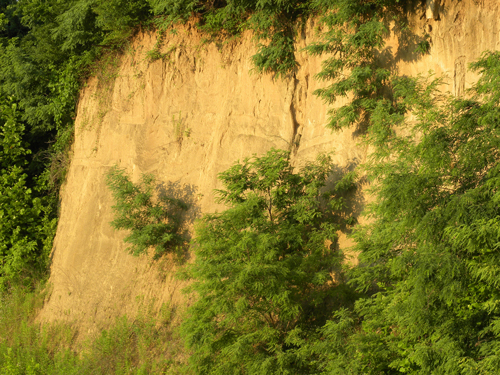Were La Véndrye’s “very fine gold-coloured sand” actually loess?
In 1728, seventy-six years before those twelve men from the Corps of Discovery arrived at the mound, the French trader and explorer Pierre La Vérendrye (1685-1749) applied a slightly different name to it. Bent on finding a water route to the Pacific Ocean, La Vérendrye had traveled west from Montreal as far as Lake Winnepeg, where he encountered a Cree[1]Cree was a common contraction of tribal names variously spelled Cristineau or Knistanoe, etc. The Crees controlled a large commercial trading region that extended from central Canada well into … Continue reading Indian named Pako, who told him that he could follow the Red River of the North southward to the Missouri River, which in turn would lead him toward the ocean.[2]G. Hubert Smith, The Explorations of the La Vérendryes in the Northern Plains, 1738-43, W. Raymond Wood, editor (Lincoln: University of Nebraska Press, 1980), 19. Chief Pako also passed along some further information that evidently aroused the Frenchman’s curiosity. His journal entry reads as follows:
C’est de ce mê me côté du fleuve vien plus bas qu’est une petite montagne dont les pierres brillent la nuit et le jour. Les Sauvages l’appellent la demeure de l’Esprit, personne n’ose en approcher, cette espece de montagne et la riviere Rouge, où il se trouve par endroit un sable fort fin couleur d’or, semble quelque chose de précieux à toutes les Nations des environs.
On the same side of the river [presumably the Red River of the North], but much lower down, there is a small mountain, the stones of which sparkle night and day. The savages call it the Dwelling of the Spirit; no one ventures to go near it. This kind of mountain and the Red river, where in places a very fine gold-coloured sand is found, seem to all the nations of the region something very precious.[3]Journals and Letters of Pierre Gaultier de Varennes de La Vérendrye and his sons: with correspondence between the governors of Canada an the French court, touching the search for the western sea, … Continue reading
Wind-blown Loess
La Vérendrye’s report contains several puzzling statements. To begin with, the location of the “small mountain” is ambiguous, and the identity of those “sparkling stones” is evidently fanciful. Then there’s Pako’s reference to that “very fine gold-coloured sand,” which suggested that the “little mountain” was located in a fabulous land, an Eldorado, of precious natural riches.[4]G. Hubert Smith, The Explorations of the La Vérendryes in the Northern Plains, 1738-43, ed. by W. Raymond Wood (Lincoln: University of Nebraska Press, 1980), 19. Coincidentally, Captain Clark made an on-site observation that seems to coincide with Pako’s description. Two days before reaching the White Stone River, he related:
“The Wind blew hard [from the] West and raised the Sands off the bar in Such Clouds that we Could Scercely See this Sand being fine and verry light Stuck to every thing it touched, and in the Plain for half a mile the distance I was out every Spire of Grass was covered with the Sand or Dust.”
That “fine and verry light” sand was most likely wind-blown loess (pron. luhss), which consists of pale yellow or buff grains of rich, dust-like soil containing crystals of quartz, feldspar, mica, and other minerals. It originated beneath the glaciers of the Ice Age as a sediment called “glacial flour.” Flushed ahead of the slowly advancing ice by glacial meltwaters, it spread out onto the floodplains of the Missouri and Mississippi Rivers, where it settled and dried out as winter reduced the river levels. Then, mighty western gales redistributed the loess in hills up to 200 feet high along both sides of the rivers.
The place name as La Vérendrye understood it, “Dwelling of the Spirit,” is broadly consistent with the names Lewis and Clark’s informants gave them for Spirit Mound, and the phrase “no one ventures to go near it” is, verbatim, the essential theme in its story. Nevertheless, although there may have been other mounds of similar importance in that part of the midwest, according to historian Clyde Dollar the Spirit Mound story as it appeared in the journals of Lewis and Clark was “one of the few truly unique tales in the upper Missouri area.”[5]Clyde D. Dollar (1932-1983), “The Journal of Charles Le Raye: Authentic or Not?” in South Dakota Historical Collections, Vol. 41 (1982), 189. Furthermore, those spirits that dwelt on today’s Spirit Mound are not called sacred in any account by anyone, whether Native or Euro-American. On the contrary, they were evil. They were “deavels” whose only role was to drive off or kill trespassers.
Notes
| ↑1 | Cree was a common contraction of tribal names variously spelled Cristineau or Knistanoe, etc. The Crees controlled a large commercial trading region that extended from central Canada well into present North Dakota and Montana. Moulton, Journals, 3:3, 120n 235-37, 235n, 126n, 236n, 246, 317, 412-13, 480-34, 487, 4:35; 6:124n; 10:43n, 60n. |
|---|---|
| ↑2 | G. Hubert Smith, The Explorations of the La Vérendryes in the Northern Plains, 1738-43, W. Raymond Wood, editor (Lincoln: University of Nebraska Press, 1980), 19. |
| ↑3 | Journals and Letters of Pierre Gaultier de Varennes de La Vérendrye and his sons: with correspondence between the governors of Canada an the French court, touching the search for the western sea, Trans. Lawrence Johnstone Burpee for the Champlain Society in 1927 (Westport, Connecticut: Greenwood Press, 1968), 45. |
| ↑4 | G. Hubert Smith, The Explorations of the La Vérendryes in the Northern Plains, 1738-43, ed. by W. Raymond Wood (Lincoln: University of Nebraska Press, 1980), 19. |
| ↑5 | Clyde D. Dollar (1932-1983), “The Journal of Charles Le Raye: Authentic or Not?” in South Dakota Historical Collections, Vol. 41 (1982), 189. |

